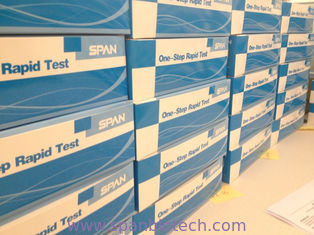|
|
Luteinizing Hormone(LH) Elisa Test Kit for Diagnostic Use
|
Product Details:
Payment & Shipping Terms:
|
| Specificity: | 100% |
|---|
Luteinizing Hormone(LH) Elisa Test Kit for Diagnostic Use
Intended use
Immunoassay for the in vitro quantitative determination of luteinizing hormone in human serum.
Summary
LH (luteinizing hormone), together with FSH (follicle stimulating hormone), belongs to the gonadotropin family. LH and FSH regulate and stimulate the growth and function of the gonads (ovaries and testes) synergistically. Like FSH, TSH and hCG, LH is a glycoprotein consisting of two subunits (α- and β-chains). (1, 2, 3) This proteohormone, which consists of 121 amino acidsand three sugar chains, has a molecular weight of 29500 daltons.In women, the gonadotropins act within the hypothalamus-pituitary-ovaryregulating circuit to control the menstrual cycle. (4, 5) LH and FSH are released in pulses from the gonadotropic cells of the anteriorpituitary and pass via the bloodstream to the ovaries. Here the gonadotropinsstimulate the growth and maturation of the follicle and hence the biosynthesisof estrogens and progesterones. The highest LH-concentrations occur duringthe mid-cycle peak and induce ovulation and formation of the corpus luteum,the principal secretion product of which is progesterone. In the Leydig cells
of the testes, LH stimulates the production of testosterone.Determination of the LH concentration is used in the elucidation ofdysfunctions within the hypothalamus-pituitary-gonads system.The determination of LH in conjunction with FSH is utilized for the followingindications: congenital diseases with chromosome aberrations (e.g. Turner’ssyndrome), polycystic ovaries (PCO), clarifying the causes of amenorrhea,menopausal syndrome, and suspected Leydig cell insufficiency. (1, 4, 5)
Test principle
Sandwich principle. Total duration of assay: 80 minutes.
• Sample, Anti-LH coated microwells and enzyme labeled Anti-LH are combined.
• During the incubation, LH presents in the sample is allowed to react simultaneously with the two antibodies, resulting in the LH molecules being sandwiched between the solid phase and enzyme-linked antibodies.
• After washing, a complex is generated between the solid phase, the LH within the sample and enzyme-linked antibodies by immunological reactions.
• Substrate solutionis then added and catalyzed by this complex, resulting in a chromogenic reaction. The resulting chromogenic reaction is measured as absorbance.
• The absorbance is proportional to the amount of LH in the sample.
Reagents
Materials provided
• Coated Microplate, 8 x 12 strips, 96 wells, pre-coated with mouse monoclonal Anti-LH.
• Calibrators, 6 vials, 1 ml each, ready to use; Concentrations: 0(A), 5(B), 20(C), 50(D), 100(E) and 200(F) mIU/mL.
• Enzyme Conjugate, 1 vial, 11 mL of HRP(horseradish peroxidase) labeled mouse monoclonal Anti-LH in Tris-NaCl buffer containing BSA (bovine serum albumin). Contains 0.1% ProClin300® preservative.
• Substrate, 1 vial, 11ml, ready to use, (tetramethylbenzidine) TMB.
• Stop Solution, 1 vial, 6.0 ml of 1 mol/L sulfuric acid.
• Wash Solution Concentrate, 1 vial, 25 mL(40X concentrated), PBS-Tween wash solution.
• IFU, 1 copy.
• Plate Lid: 1 piece.
Materials required (but not provided)
• Microplate reader with 450nm and 620nm wavelength absorbent capability.
• Microplate washer.
• Incubator.
• Plate shaker.
• Micropipettes and multichannel micropipettes delivering 50μl with a precision of better than 1.5%.
• Absorbent paper.
• Distilled water
Precautions and warnings
• For in vitro diagnostic use only. For professional use only.
• All products that contain human serum or plasma have been found to be non-reactive for HBsAg, HCV and HIVI/II. But all products should be reared as potential biohazards in use and for disposal.
• Mix the sample in the wells thoroughly by shaking and eliminate the bubbles.
• Conduct the assay away from bad ambient conditions. e.g. ambient air containing high concentration corrosive gas such as sodium hypochlorite acid, alkaline, acetaldehyde and so on, or containing dust.
• Wash the wells completely. Each well must be fully injected with wash solution. The strength of injection, however, is not supposed to be too intense to avoid overflow. In each wash cycle, dry the liquids in each well. Strike the microplate onto absorbent paper to remove residual water droplets. It is recommended to wash the microplate with an automated microplate strip washer.
• Failure to remove adhering solution adequately in the aspiration or decantation wash step(s) may result in poor replication and spurious results.
• Do not use reagents beyond the labeled expiry date.
• Do not mix or use components from kits with different batch codes.
• If more than one plate is used, it is recommended to repeat the calibration curve.
• It is important that the time of reaction in each well is held constant to achieve reproducible results.
• Ensure that the bottom of the plate is clean and dry.
• Ensure that no bubbles are present on the surface of the liquid before reading the plate.
• Thesubstrate and stop solution should be added in the same sequence to eliminate any time deviation during reaction.
Storage
• Store at 2-8℃.
• Place unused wells in the zip-lock aluminum foiled pouch and return to 2-8 °C, under which conditions the wells will remain stable for 2 months, or until the labeled expiry date, whichever is earlier.
• Seal and return unused calibrators to 2-8 °C, under which conditions the stability will be retained for 1 month, for longer use, store opened calibrators in aliquots and freeze at -20 °C. Avoid multiple freeze-thaw cycles.
• Seal and return all the other unused reagents to 2-8 °C, under which conditions the stability will be retained for 2 months, or until the labeled expiry date, whichever is earlier.
Rebecca Yan
Span Biotech Ltd.
Tel: +86(755)89589611
Cell Phone:+8618823462100(WhatsApp)
Web:www.spanbio.com
Contact Person: Ms. Anna Lee
Tel: +86-755-89589611
Fax: 86-755-89580096
-
Albulin (Alb ) Elisa Test Kit for Diagnostic Use
-
β2-Microglobulin (β2-MG) Elisa Test Kit for Diagnostic Use
-
Carbohydrate Antigen 50 (CA-50) Elisa Diagnostic Kit for Diagnostic Use
-
Carbohydrate Antigen 19-9 (CA19-9) Elisa Test Kit for Diagnostic Use
-
Carbohydrate Antigen 15-3 (CA15-3) Elisa Test Kit for Diagnostic Use
-
Carbohydrate Antigen 125(CA-125)Elisa Test Kit for Diagnostic Use




